 Technology peripherals
Technology peripherals
 AI
AI
 Beihang University breaks down modal barriers and introduces a universal physical combat method across visible and infrared modes.
Beihang University breaks down modal barriers and introduces a universal physical combat method across visible and infrared modes.
Beihang University breaks down modal barriers and introduces a universal physical combat method across visible and infrared modes.
In recent years, research on the safety assessment of visual perception systems has gradually deepened. Researchers have successfully developed visible light modal safety assessment technology based on different carriers such as glasses, stickers, clothing, etc., and there are also Some new attempts at infrared modalities. However, these technologies can only be applied to a single modality
With the development of artificial intelligence technology, visible-thermal infrared imaging technology has been widely used in security monitoring, autonomous driving and other security On a critical mission. Visible light imaging can provide rich texture information during the day, while infrared imaging can clearly display the thermal radiation distribution of the target at night. Using the two together, the visual perception system can achieve 24-hour full coverage and is not subject to environmental restrictions, which has many advantages. Therefore, there is a need to study a unified security assessment method for multi-modal visual perception systems
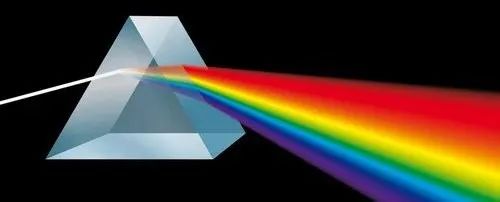
However, achieving multi-modal assessment is extremely challenging. First, it is difficult to apply universal attack methods under different imaging mechanisms. Previous methods were proposed based on the imaging characteristics of specific target modalities, and are difficult to work in other modalities. Furthermore, it is difficult to balance stealth performance, production cost and flexible application. It is not easy to be dual effective in visible light and the more difficult infrared mode, and it is even more difficult to achieve low-cost and convenient production and use.
Faced with many challenges, researchers from Beihang Institute of Artificial Intelligence explored the common shape attributes between visible light and infrared modalities, and innovatively proposed "cross-modal universality" "Anti-patch" to achieve visible light-infrared synchronized stealth. It selects materials that are easy to obtain, low cost, and have excellent thermal insulation properties to make convenient patches, which are ready to use. While filling the gaps in the robustness evaluation technology of visible light-infrared multi-modal detection systems in the current physical world, it also takes into account The ease and immediacy of physical implementation. Experiments demonstrate the effectiveness of this method under different detection models and modalities, as well as its generalization in multiple scenarios. Currently, this paper has been accepted by ICCV 2023.

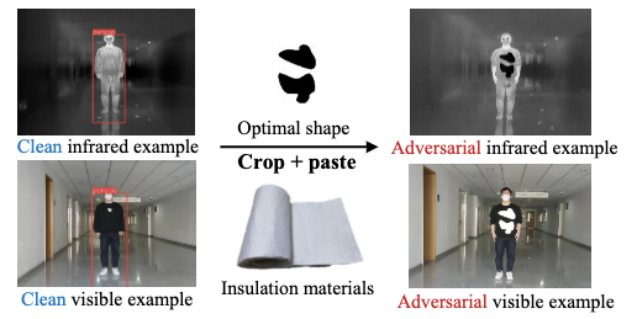
Code link: https://github.com/Aries-iai/Cross-modal_Patch_Attack
Technical points
This research uses evolutionary algorithms as the basic framework to conduct program design and effect improvement from three perspectives: shape modeling, shape optimization and modal balance. The specific process is shown in the figure below:

1. Multi-anchor shape modeling based on spline interpolation
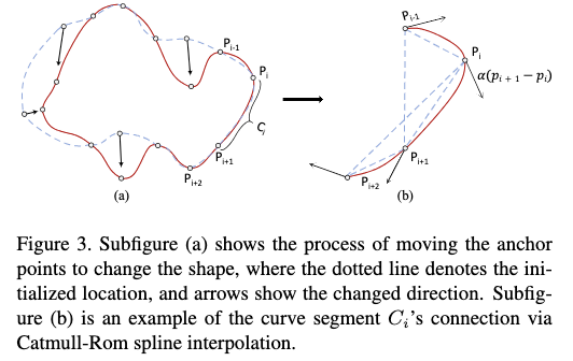
2. Boundary defining shape The optimization algorithm is based on the principle of differential evolution
Effective optimization methods are required to achieve combat. For this reason, researchers consider the evolutionary algorithm as the basic framework from the perspectives of time cost, actual effect, etc. , and improved from the two perspectives of boundary setting and fitness function:The content that needs to be rewritten is: (1) Boundary setting: By setting the boundary of the anchor point, It can improve the effectiveness of deformation and reduce time costs. The specific settings are as follows: loops or self-intersections will not be formed in the curve segment; cusps will not easily appear in the curve segment; they will not appear in the invalid area
Take anchor point About the boundary determination of the anchor point (2) Fitness function: This study is different from previous work that only conducted strike evaluation on a single mode. Instead, it focuses on the two modes of visible light and infrared, and realizes that there are natural differences between the two modes. The issue of differences in balance effects. To avoid over-optimizing a single modality while neglecting the other, the researchers proposed an innovative cross-modal fitness function based on the detector's confidence score perception, which aims to encourage exploration of successful directions and balance the two effect differences between modalities. In the end, survival of the fittest will be based on scores. In order to take into account the difference in strike difficulty between the initial stage and the later stage, this function uses an exponential function instead of a linear function to highlight the differences in strike progress at different stages The algorithm iterates the exploration process until both modes are successfully attacked and outputs the optimal shape strategy. The complete optimization process is as follows: Experiment 1: For different series of detectors Verification of cross-modal strike performance Experiment 2: Ablation experiment for shapes Experiment 3: Ablation experiment for cross-modal fitness function Experiment 4: Method under physical implementation deviation Robustness verification Experiment 5: Method effectiveness verification under different physical conditions Perform performance verification at different angles, distances, postures and scenarios, and present the results visually The core of this research is natural shape optimization, combined with deformation patches and cross-modal strikes, to design a visible-infrared multi-mode in a physical environment State robustness evaluation method. This method can evaluate the robustness of a multi-modal (visible-infrared) target detection system and effectively correct the detector model based on the evaluation results, while improving the accuracy of target image detection in both visible and infrared modes. The method is implemented and applied in a physical environment, contributing to the robustness evaluation and improvement of multi-modal detection systems as an example. The blue part in the figure below is the boundary setting legend, and the orange part is the error instance:
as an example. The blue part in the figure below is the boundary setting legend, and the orange part is the error instance: 

 The mathematical expression is as follows:
The mathematical expression is as follows: 

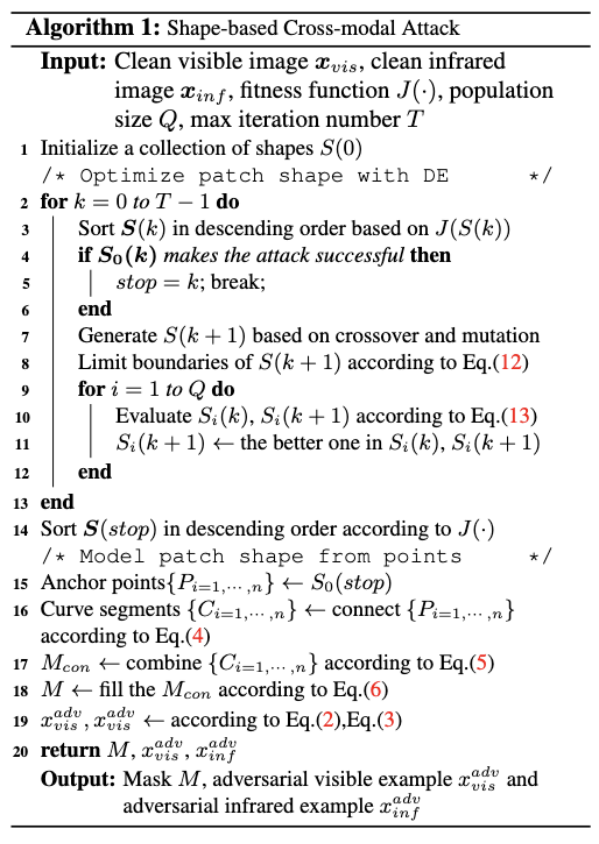
Experimental results





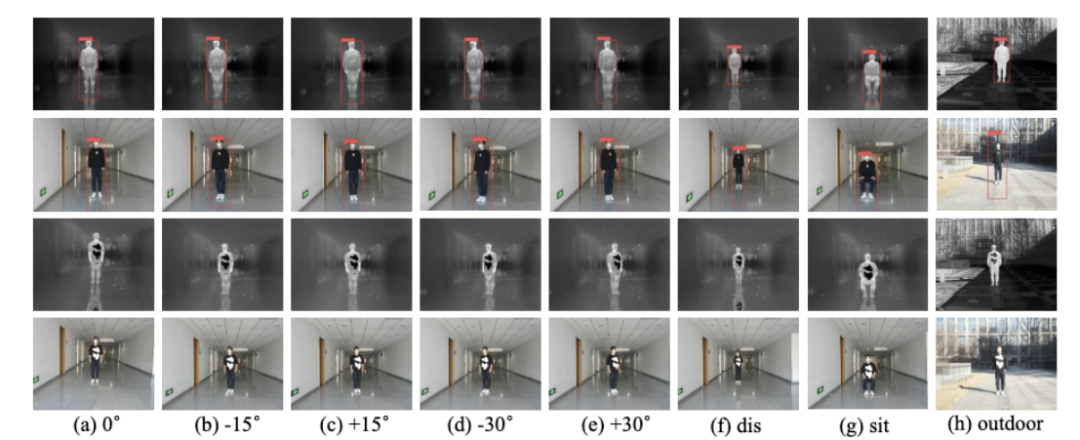
Summary
The above is the detailed content of Beihang University breaks down modal barriers and introduces a universal physical combat method across visible and infrared modes.. For more information, please follow other related articles on the PHP Chinese website!

Hot AI Tools

Undresser.AI Undress
AI-powered app for creating realistic nude photos

AI Clothes Remover
Online AI tool for removing clothes from photos.

Undress AI Tool
Undress images for free

Clothoff.io
AI clothes remover

AI Hentai Generator
Generate AI Hentai for free.

Hot Article

Hot Tools

Notepad++7.3.1
Easy-to-use and free code editor

SublimeText3 Chinese version
Chinese version, very easy to use

Zend Studio 13.0.1
Powerful PHP integrated development environment

Dreamweaver CS6
Visual web development tools

SublimeText3 Mac version
God-level code editing software (SublimeText3)

Hot Topics
 1378
1378
 52
52
 Open source! Beyond ZoeDepth! DepthFM: Fast and accurate monocular depth estimation!
Apr 03, 2024 pm 12:04 PM
Open source! Beyond ZoeDepth! DepthFM: Fast and accurate monocular depth estimation!
Apr 03, 2024 pm 12:04 PM
0.What does this article do? We propose DepthFM: a versatile and fast state-of-the-art generative monocular depth estimation model. In addition to traditional depth estimation tasks, DepthFM also demonstrates state-of-the-art capabilities in downstream tasks such as depth inpainting. DepthFM is efficient and can synthesize depth maps within a few inference steps. Let’s read about this work together ~ 1. Paper information title: DepthFM: FastMonocularDepthEstimationwithFlowMatching Author: MingGui, JohannesS.Fischer, UlrichPrestel, PingchuanMa, Dmytr
 The world's most powerful open source MoE model is here, with Chinese capabilities comparable to GPT-4, and the price is only nearly one percent of GPT-4-Turbo
May 07, 2024 pm 04:13 PM
The world's most powerful open source MoE model is here, with Chinese capabilities comparable to GPT-4, and the price is only nearly one percent of GPT-4-Turbo
May 07, 2024 pm 04:13 PM
Imagine an artificial intelligence model that not only has the ability to surpass traditional computing, but also achieves more efficient performance at a lower cost. This is not science fiction, DeepSeek-V2[1], the world’s most powerful open source MoE model is here. DeepSeek-V2 is a powerful mixture of experts (MoE) language model with the characteristics of economical training and efficient inference. It consists of 236B parameters, 21B of which are used to activate each marker. Compared with DeepSeek67B, DeepSeek-V2 has stronger performance, while saving 42.5% of training costs, reducing KV cache by 93.3%, and increasing the maximum generation throughput to 5.76 times. DeepSeek is a company exploring general artificial intelligence
 AI subverts mathematical research! Fields Medal winner and Chinese-American mathematician led 11 top-ranked papers | Liked by Terence Tao
Apr 09, 2024 am 11:52 AM
AI subverts mathematical research! Fields Medal winner and Chinese-American mathematician led 11 top-ranked papers | Liked by Terence Tao
Apr 09, 2024 am 11:52 AM
AI is indeed changing mathematics. Recently, Tao Zhexuan, who has been paying close attention to this issue, forwarded the latest issue of "Bulletin of the American Mathematical Society" (Bulletin of the American Mathematical Society). Focusing on the topic "Will machines change mathematics?", many mathematicians expressed their opinions. The whole process was full of sparks, hardcore and exciting. The author has a strong lineup, including Fields Medal winner Akshay Venkatesh, Chinese mathematician Zheng Lejun, NYU computer scientist Ernest Davis and many other well-known scholars in the industry. The world of AI has changed dramatically. You know, many of these articles were submitted a year ago.
 KAN, which replaces MLP, has been extended to convolution by open source projects
Jun 01, 2024 pm 10:03 PM
KAN, which replaces MLP, has been extended to convolution by open source projects
Jun 01, 2024 pm 10:03 PM
Earlier this month, researchers from MIT and other institutions proposed a very promising alternative to MLP - KAN. KAN outperforms MLP in terms of accuracy and interpretability. And it can outperform MLP running with a larger number of parameters with a very small number of parameters. For example, the authors stated that they used KAN to reproduce DeepMind's results with a smaller network and a higher degree of automation. Specifically, DeepMind's MLP has about 300,000 parameters, while KAN only has about 200 parameters. KAN has a strong mathematical foundation like MLP. MLP is based on the universal approximation theorem, while KAN is based on the Kolmogorov-Arnold representation theorem. As shown in the figure below, KAN has
 Hello, electric Atlas! Boston Dynamics robot comes back to life, 180-degree weird moves scare Musk
Apr 18, 2024 pm 07:58 PM
Hello, electric Atlas! Boston Dynamics robot comes back to life, 180-degree weird moves scare Musk
Apr 18, 2024 pm 07:58 PM
Boston Dynamics Atlas officially enters the era of electric robots! Yesterday, the hydraulic Atlas just "tearfully" withdrew from the stage of history. Today, Boston Dynamics announced that the electric Atlas is on the job. It seems that in the field of commercial humanoid robots, Boston Dynamics is determined to compete with Tesla. After the new video was released, it had already been viewed by more than one million people in just ten hours. The old people leave and new roles appear. This is a historical necessity. There is no doubt that this year is the explosive year of humanoid robots. Netizens commented: The advancement of robots has made this year's opening ceremony look like a human, and the degree of freedom is far greater than that of humans. But is this really not a horror movie? At the beginning of the video, Atlas is lying calmly on the ground, seemingly on his back. What follows is jaw-dropping
 Slow Cellular Data Internet Speeds on iPhone: Fixes
May 03, 2024 pm 09:01 PM
Slow Cellular Data Internet Speeds on iPhone: Fixes
May 03, 2024 pm 09:01 PM
Facing lag, slow mobile data connection on iPhone? Typically, the strength of cellular internet on your phone depends on several factors such as region, cellular network type, roaming type, etc. There are some things you can do to get a faster, more reliable cellular Internet connection. Fix 1 – Force Restart iPhone Sometimes, force restarting your device just resets a lot of things, including the cellular connection. Step 1 – Just press the volume up key once and release. Next, press the Volume Down key and release it again. Step 2 – The next part of the process is to hold the button on the right side. Let the iPhone finish restarting. Enable cellular data and check network speed. Check again Fix 2 – Change data mode While 5G offers better network speeds, it works better when the signal is weaker
 The vitality of super intelligence awakens! But with the arrival of self-updating AI, mothers no longer have to worry about data bottlenecks
Apr 29, 2024 pm 06:55 PM
The vitality of super intelligence awakens! But with the arrival of self-updating AI, mothers no longer have to worry about data bottlenecks
Apr 29, 2024 pm 06:55 PM
I cry to death. The world is madly building big models. The data on the Internet is not enough. It is not enough at all. The training model looks like "The Hunger Games", and AI researchers around the world are worrying about how to feed these data voracious eaters. This problem is particularly prominent in multi-modal tasks. At a time when nothing could be done, a start-up team from the Department of Renmin University of China used its own new model to become the first in China to make "model-generated data feed itself" a reality. Moreover, it is a two-pronged approach on the understanding side and the generation side. Both sides can generate high-quality, multi-modal new data and provide data feedback to the model itself. What is a model? Awaker 1.0, a large multi-modal model that just appeared on the Zhongguancun Forum. Who is the team? Sophon engine. Founded by Gao Yizhao, a doctoral student at Renmin University’s Hillhouse School of Artificial Intelligence.
 FisheyeDetNet: the first target detection algorithm based on fisheye camera
Apr 26, 2024 am 11:37 AM
FisheyeDetNet: the first target detection algorithm based on fisheye camera
Apr 26, 2024 am 11:37 AM
Target detection is a relatively mature problem in autonomous driving systems, among which pedestrian detection is one of the earliest algorithms to be deployed. Very comprehensive research has been carried out in most papers. However, distance perception using fisheye cameras for surround view is relatively less studied. Due to large radial distortion, standard bounding box representation is difficult to implement in fisheye cameras. To alleviate the above description, we explore extended bounding box, ellipse, and general polygon designs into polar/angular representations and define an instance segmentation mIOU metric to analyze these representations. The proposed model fisheyeDetNet with polygonal shape outperforms other models and simultaneously achieves 49.5% mAP on the Valeo fisheye camera dataset for autonomous driving



